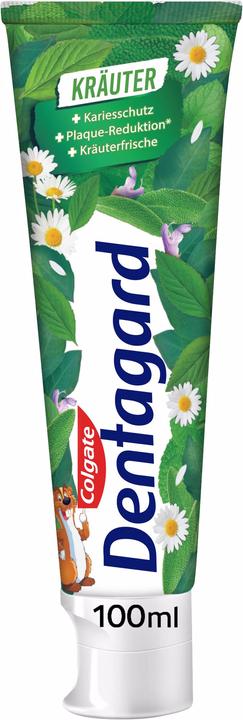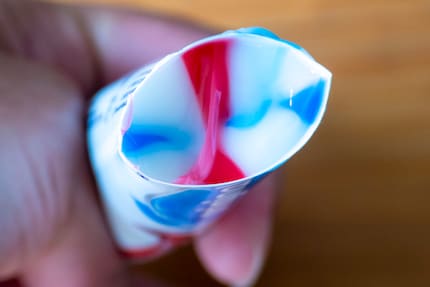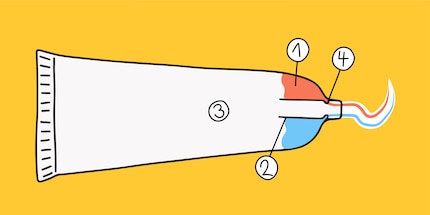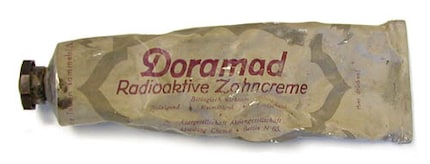
Colgate Total Original
75 ml

No matter where I squeeze or how much’s left in the tube, toothpaste always comes out in perfect stripes. How’s that possible?
Just before going to bed, I squeeze the last bit of toothpaste onto my toothbrush. To my surprise, although there’s hardly any paste left, the white, red and blue lines are perfectly shaped. How’s this possible?
Signal (link in German) introduced the first striped toothpaste in Switzerland and Germany in 1961. At that time, the stripes were designed to create a so-called special mouthwash effect and didn’t yet contain fluoride. Today, they serve a decorative purpose and have no health benefits. They don’t improve dental hygiene either. In fact, the blue and red parts are exactly the same as the white part of the toothpaste, just coloured.

Colgate Total Original
75 ml

Colgate Dentagard
100 ml

Signal Fresh Gel Family Pack
125 ml
There are two methods of getting the stripes into the toothpaste. Some manufacturers fill coloured paste into the tube in long stripes. You can see these stripes when you cut open the tube. However, the emptier the tube gets, the messier the stripes look as they’re squeezed out.

In this method, the coloured paste (1) is filled into the front of the tube first. A partition (2) separates it from the white paste. Then, the tube’s filled with the main paste (3) and sealed. When you squeeze the tube, the coloured paste passes through small holes or slits (4) into the white paste, creating the fine stripes. As the pressure’s evenly distributed, it doesn’t matter where you squeeze the tube. The stripes always come out perfectly.

Although today’s colourful toothpaste stripes don’t have any positive health effects, they don’t do any harm either. This can’t be said of the radioactive toothpaste Doromad, which was produced by Berlin company Auergesellschaft AG. According to the ORAU, the Museum of Radiation and Radioactivity, it contained thorium, a slightly radioactive heavy metal, in the 1940s. This mixture was said to strengthen the gums, kill bacteria and prevent dental tartar. However, after the atomic bombs were dropped in Hiroshima and Nagasaki and the world realised how damaging radiation is, this toothpaste quickly disappeared from the market.

Want to know more about teeth? Editor Patrick Vogt interviewed senior physician Eirini Stratigaki about chalk teeth and why they’re becoming more and more common.
Painting the walls just before handing over the flat? Making your own kimchi? Soldering a broken raclette oven? There's nothing you can't do yourself. Well, perhaps sometimes, but I'll definitely give it a try.
Interesting facts about products, behind-the-scenes looks at manufacturers and deep-dives on interesting people.
Show all